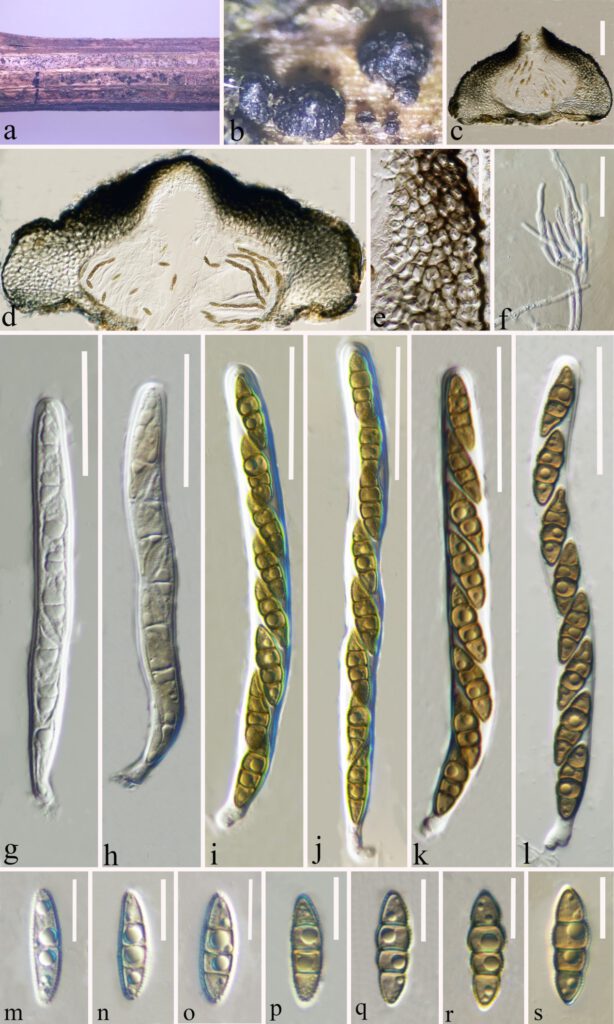Leptosphaeria zhaotongensis Y. Gao, H. Gui & K.D. Hyde, sp. nov.
MycoBank number: MB; Index Fungorum number: IF; Facesoffungi number: FoF 12904; FIGURE 4.GG.
Etymology: The specific epithet “zhaotongensis” refers to Zhaotong city where the holotype was collected.
Holotype: HKAS 124664
Saprobic on decaying stalk of herb. Sexual morph: Ascomata 380–550 μm diam × 185–300 μm high (x̅ = 461 × 234 μm, n = 15), solitary, scattered or in small groups, erumpent to superficial, globose to subglobose, smooth-walled, easily removed from the host substrate, with a flattened base, black, coriaceous, uni-loculate, glabrous, ostiolate. Ostiole apex with a conical with papilla. Peridium (35–)66–116.5(–127) μm thick, (x̅ = 91 μm, n = 40), thin wall at base and top, thick wall at two sides, composed of 4–8 layers of flattened, light brown to dark brown cells of textura angularis. Hamathecium (1.5–)2–2.6(–3) μm wide, (x̅ = 2.3 μm, n = 50), straight, septate, hyaline, branched, cellular pseudoparaphyses, partially embedded in a gelatinous matrix. Asci (84–)92–113(–118) × (7.7–)8.2–10(–11) μm (x̅ = 102 × 9 μm, n = 30), 8-spored, arising from the base, bitunicate, fissitunicate, cylindrical to cylindric-clavate, apically rounded, short pedicellate with foot-like pedicel, hyaline, with ocular chamber. Ascospores (16.2–)17.6–20(–21.3) × (4.5–)4.8–5.7(–6.5) μm (x̅ = 18.7 × 5.2 μm, n = 40), uniseriate, partially overlapping, fusiform, with narrow to acute at both ends, guttulate, initially hyaline with 1-transverse septum, becoming yellowish brown, 3-septate at maturity, broader cells above central septum, often slightly constricted at septum, conical at both end, sometimes rough-walled, without mucilaginous sheath. Asexual morph: Undetermined.
Material examined: CHINA, Yunnan Province, Zhaotong city, Daguan County Grassland (27°44’23”N, 103°47’59”E), on decaying stalk of herbaceous plant, 21 August 2021, Ying Gao, GG (HKAS 124664, holotype).
Note: Based on our phylogenetic analysis of the combined SSU, LSU, ITS, tub2 and rpb2 sequence data, our novel species Leptosphaeria zhaotongensis cluster with the strain of Leptosphaeria cichorium (MFLUCC:141063) with 95% ML, 1.00 PP bootstrap support (Figure 1). There are also great differences between Leptosphaeria zhaotongensis and Leptosphaeria cichorium in morphological descriptionLeptosphaeria zhaotongensis differs Leptosphaeria cichorium in bigger ascomata (384–551 × 186–292 μm vs. 206–240 × 251–363 μm), greater ascospores (16–21 × 5–7 μm with guttulate vs. 11–20 × 3–6 μm without guttulate). A nucleotide pairwise comparison showed that Leptosphaeria zhaotongensis differs from Leptosphaeria cichorium in 62/521 bp of ITS (11.9%). Following the guidelines for species delineation described by Jeewon and Hyde (2016), we introduce Leptosphaeria zhaotongensis as a novel taxon

FIGURE4 GG. Leptosphaeria zhaotongensis (HKAS 124664 holotype) on decaying stalk of herbaceous plant. a, b. Ascomata on the host. c, d. Vertical section of the ascoma. e. Peridium. f. Hermathecium. g–l. Asci. m–s. Ascospores. Scale bars: c–d = 100 μm. e = 30 μm. f = 20 μm. g–l = 30 μm. m–s = 10 μm.
